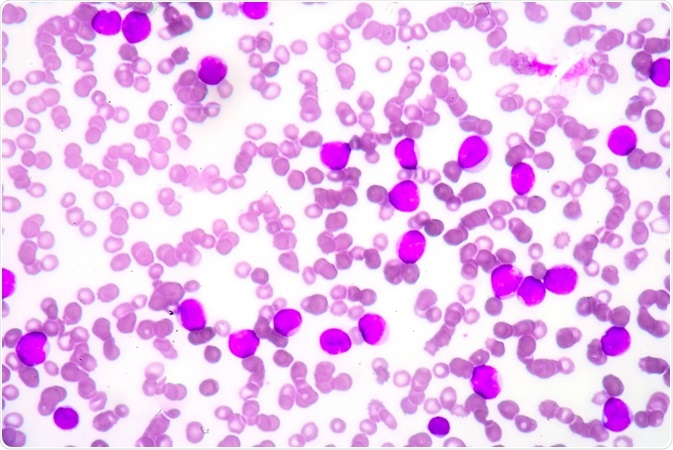Aplastic anemia is a rare disorder characterized by inadequate production of blood cells by the bone marrow. The bone marrow is a spongy tissue inside the bones, where all the blood cells (red blood cells, platelets, and white blood cells) are synthesized. The red blood cells are important for supplying oxygen to other cells of the body, whereas white blood cells fight infections, and platelets help in blood clotting.
 Image Credits: Schira / Shutterstock.com
Image Credits: Schira / Shutterstock.com
What causes aplastic anemia?Aplastic anemia may be either acute or chronic and can develop at any age. It tends to be more common in young people, however. Aplastic anemia increases the risk of leukemia and other blood disorders. If untreated, aplastic anemia can lead to serious consequences such as arrhythmia and heart failure.
Aplastic anemia develops when the bone marrow is damaged, and it can no longer synthesize enough stem cells. Stem cells are cells that give rise to other blood cells.
For most cases of aplastic anemia, the cause is unknown. However, there are several causes that have been identified as the causative factors in some patients.
In some cases, an autoimmune reaction, in which the body’s immune system attacks its own tissues and organs, is held responsible for the bone marrow damage. T cells of the immune system attack the hematopoietic stem cells and destroy them; this suppresses blood cell production and the subsequent process of cell division.
Medications and some environmental toxins are other factors that may trigger aplastic anemia. Chemotherapy and radiation are commonly used in cancer to destroy the cancer cells; however, they can also harm healthy cells, such as the blood cells in the bone marrow. Certain arthritis drugs and antibiotics can also cause aplastic anemia, although the risk with such drugs is very low. Exposure to pesticides, insecticides, and some viruses has also been linked to aplastic anemia. Aplastic anemia can also be associated with pregnancy; however, this form of aplastic anemia is self-limited and ends with delivery.
Inherited forms of aplastic anemia are caused by genetic factors and are usually observed in the first decade of life. Fanconi anemia is the term used to specify hereditary forms of aplastic anemia.
What are the symptoms of aplastic anemia?
The characteristic symptoms of aplastic anemia include anemia (due to lack of red blood cells), infections (due to lack of white blood cells), and uncontrolled bleeding or bruising (due to lack of platelets). In some cases, the affected person is asymptomatic, and the condition is detected during a routine blood test.
Aplastic anemia makes the affected person anemic due to decreased levels of red blood cells. Aplastic anemia also leads to uncontrolled bleeding and makes the person highly prone to infections. Uncontrolled bleeding is caused by low platelets, while the increased susceptibility to infections is caused by low white blood cells.
Fatigue, dizziness, shortness of breath, irregular heart rate, pale skin, skin rash, and headache are observed with aplastic anemia.
How is aplastic anemia diagnosed?
Blood and laboratory tests are used to detect aplastic anemia. Bone marrow aspiration and biopsy may also be conducted to confirm diagnoses. In this procedure, a needle is inserted through a bone to remove a small amount of bone marrow tissue. The tissue is then examined under a microscope to determine to look for evidence of abnormal bone marrow structure and lack of stem cells.
How is aplastic anemia treated?
Management of aplastic anemia involves removing the underlying cause. Aplastic anemia can be treated with medications that suppress the immune system, blood transfusions, or bone marrow transplant.
Blood transfusions: Platelet transfusions help to reduce the risk of hemorrhage and are hence performed first. Red blood cell transfusions help in decreasing the fatigue and shortness of breath associated with aplastic anemia. White blood cell transfusions provide patients with infection-fighting cells, while their own immune systems are weak from lack of white blood cell production. The process provides temporary relief and rarely leads to long-term recovery. Though blood transfusions are usually safe, some patients may experience fever, infections, or allergic reactions.
Bone marrow transplant: In bone marrow transplantation, the affected person’s bone marrow is destroyed with radiation or drugs and replaced with bone marrow from a compatible donor. Donors are usually family members, such as siblings. Patients below 40 of age have the best outcomes, and the success rates significantly decline in patients over the age of 40. If successful, bone marrow transplantation can be curative for aplastic anemia, and relapses occur rarely. However, there are chances of developing sterility and hair loss. Serious immune complications and infections can also occur with this intensive procedure.
Drugs that suppress the immune system: Hematopoietic stem cell transplantation, which uses stem cells from circulating blood, may be performed; however, it is not suitable for certain patients because of advanced age, comorbidities, or lack of a suitable donor. In such patients, immunosuppressive drugs such as cyclosporine and anti-thymocyte globulin are used to treat aplastic anemia. Drug therapy may help to restore the production of blood cells; however, it is not a definite cure. In around half of the patients, relapses occur. In some patients, it may also lead to other blood-forming disorders or cancer. The side effects related to these immunosuppressive drugs include high blood pressure, fever, and kidney problems.
Further Reading